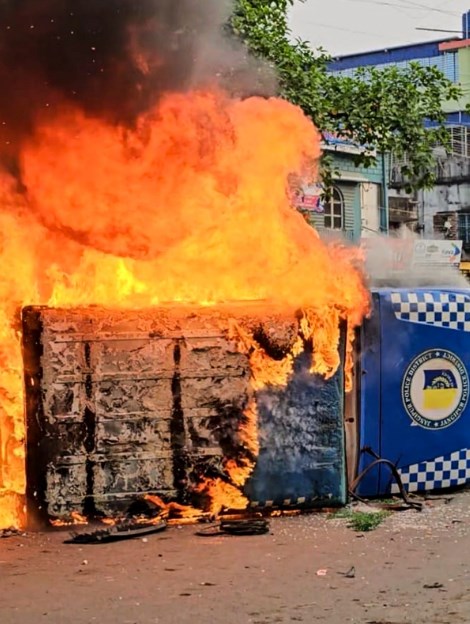Search here

14-Apr-2025 , Updated on 4/14/2025 10:26:40 PM
Murshidabad: Hindus Forced To Leave Their Home
Several Hindu families faced mass displacement in the culturally and historically important district of Murshidabad in April 2025. The crisis revealed existing religious tensions throughout the area as well as serious problems about state management combined with concerns about public safety and political influence on public turmoil.
Background of the Crisis
The diversely populated Murshidabad region has normally experienced minimal social unrest with occasional periods of conflict. A new flare-up of unrest emerged solely because of protests against the Waqf (Amendment) Act 2025 that the central government had initiated. The Waqf (Amendment) Act 2025 implemented substantial changes in the way that supervises and manages properties designated as Waqf religious endowments managed by Islamic charities.
The supporters claimed the Act offered enhanced Waqf property oversight, but Muslim organisations, together with political parties, stated it infringed upon spiritual independence. The presence of numerous Muslims in West Bengal established the state as an active center of opposition activities against this legislation. The assurance from West Bengal Chief Minister Mamata Banerjee about avoiding the law implementation failed to stop growing protests in the Murshidabad areas of the state.
The Outbreak of Violence
Protests that started peacefully in April 2025 became violent on the 8th of that month. Protestors in Dhulian, together with others in other parts of Murshidabad, cut off National Highway 12 and damaged public property while torching police vehicles. The incident disrupted train operations along with incidents of rioters who targeted state office buildings, including the Member of Parliament office.
The protest, which started against central legislation, transformed into dangerous communal violence. The situation intensified to such an extent that Hindu residents around the area started experiencing unsafe conditions. The residents of the area left their properties and income sources behind after they experienced feelings of targeted violence.
Displacement of Hindu Families
Through statements to national media, Suvendu Adhikari revealed that more than 400 Hindus from Dhulian ran away to the Malda district across the river. Displaced people found shelter in Par Lalpur High School and other community centers, along with school, after they fled violence.
Displaced Hindu families reported receiving threats from aggressors, along with intimidation through physical violence. During the disorder, people who left their homes asserted that their properties had been pillaged and vandalised. Men, women and children, resided in overcrowded tents while the survivors remained unsure whether they could return home or whether attacks would occur again.
Political Blame Game
Similar to other similar cases, political parties quickly launched accusations against each other regarding the handling and potential motivation behind the disturbances. The Bharatiya Janata Party accused the Trinamool Congress government of failing to address extremist groups through what they called “appeasement politics” while showing no sign of controlling the extremism that emerged in the region.
The TMC party blamed the BJP party for turning a social issue into a political one by using false information through social media platforms. Rajya Sabha MP Sagarika Ghose and other TMC leaders stated that the BJP distributed pictures and videos originating from outside West Bengal to create false impressions of Murshidabad as a violent area.
The actual situation persisted without change because numerous families lost their homes, while the peaceful social relations in Murshidabad suffered severe damage.
Government and Legal Response
The state government implemented Section 144 and restricted internet access to stop individuals from gathering in groups bigger than four under its provisions along with halting internet services to slow down disruptive content sharing. The implementation of these measures occurred when most of the harm had already spread throughout the region.
The Calcutta High Court initiated legal action by itself to order federal paramilitary forces together with Border Security Force (BSF) personnel deployment in conflict zones. The Border Security Force sent five extra companies to join local law enforcement for maintaining order while stopping new conflicts from developing.
The court mandated the state government to maintain security for the displaced families while submitting a thorough investigation of violence sources as well as its scope to the court.
Humanitarian Concerns and Social Impact
The humanitarian situation that developed from the Murshidabad incident poses grave concerns which extend past the legal and political aspects of the situation. The displaced families suffer various impacts from this communal violence, which starts with homelessness, followed by education disruptions for children and leads to enduring trauma and constant feelings of insecurity.
The displaced Hindu families experience economic and physical peril. These displaced people included residents who kept small shops combined with wage labor responsibilities and farming operations that now struggle to sustain themselves. The forced relocation of these families has broken down the local markets and generated new conflicts in the areas where they reside for shelter.
Several social activists, together with civil society organisations, demand prompt and impartial assistance for all impacted families without considering their religious backgrounds. Social leaders from Hindu and Muslim communities need to start dialoguing to restore peace together with building mutual trust between both communities.

Content Writer
Creative & detailed oriented content writer with 1.5 years of experience in crafting engaging blogs, articles, product descriptions, website content. Ability to develop compelling narratives that enhance brand visibility.
Join Our Newsletter
Subscribe to our newsletter to receive emails about new views posts, releases and updates.
Copyright 2010 - 2025 MindStick Software Pvt. Ltd. All Rights Reserved Privacy Policy | Terms & Conditions | Cookie Policy